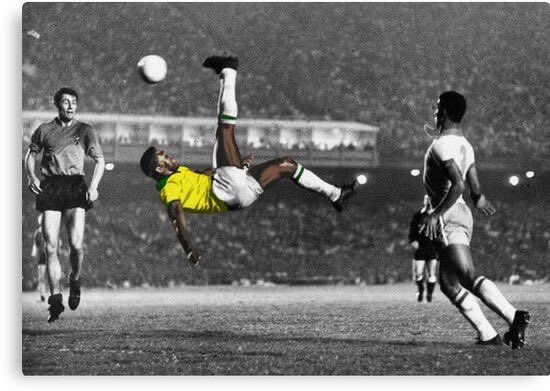Passing of Soccer King, 82, is Worldwide News
Buffalo Columnist Says Blizzard Surfaced Racists
Small Paper’s Alarm on Santos Was Ignored
U.S. Capitol Features Tributes to 140 Enslavers
Reporter Finds Russian ‘Vassal State’ in Africa
Uganda Paper Exposes Saudis’ Human Trafficking
Watch, Listen to the Top African Songs of 2022
Short Takes: T.J. Holmes and Amy Robach; Donald Hunt; “A journalist’s guide to reporting on homelessness”; Black journalists who helped to integrate pro football; N.Y. Times op-doc on short list for Oscar; Algerian editor in detention.
Homepage photo: Thiago Silva/Twitter
Support Journal-ismsDonations are tax-deductible.
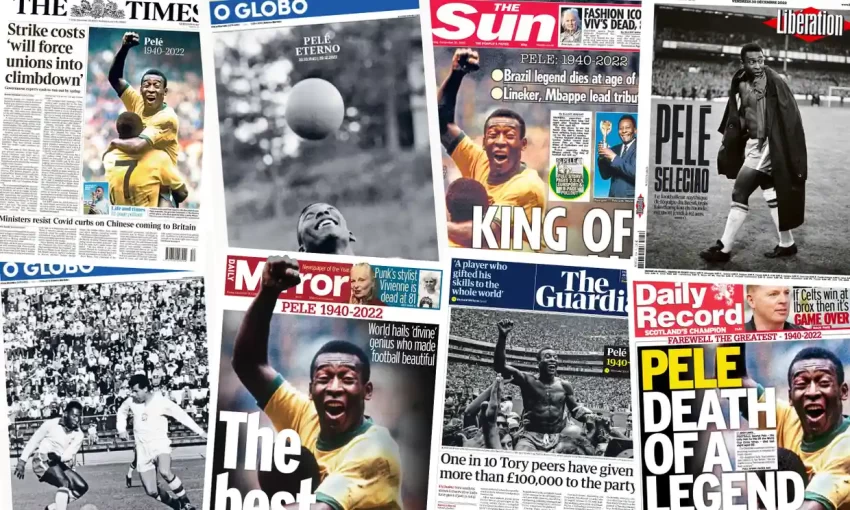
Passing of Soccer King, 82, is Worldwide News
“His face appeared on televisions around the world and dominated the homepages of news outlets everywhere as global media bowed to the late, great Pele, the undisputed ‘King’ of football,” Yann Bernal wrote Friday for Agence France-Presse.
“News organisations across the planet hailed the legendary Brazilian, who died Thursday at the age of 82 and was widely considered the greatest footballer to ever play the game and stood alone as the only one in history to win three World Cups. . . .”
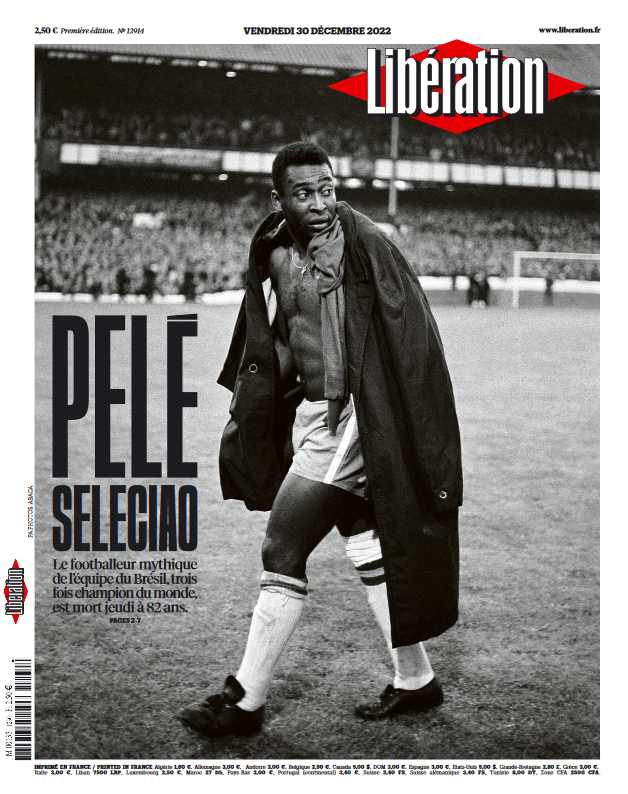 Jonathan Yerushalmy added in The Guardian, “One of Brazil’s main [papers], O Globo, has printed an unprecedented four editions, with different covers marking different points in Pelé’s career. The paper’s headline simply reads ‘Pelé Eterno’ – in English, ‘Pelé Eternal’.
Jonathan Yerushalmy added in The Guardian, “One of Brazil’s main [papers], O Globo, has printed an unprecedented four editions, with different covers marking different points in Pelé’s career. The paper’s headline simply reads ‘Pelé Eterno’ – in English, ‘Pelé Eternal’.
“Spain’s El País says ‘Goodbye to Pelé, “the king” of football’ with an image of that iconic World Cup win in 1970.
“French sports daily L’Équipe adopts the Brazilian colours on its front pages. With a full-page image of a young Pelé, the paper says ‘He was a king’.
“To the Brazilian daily O Globo, whose front page was packed with stories about the sporting legend, Pele may have died, but he remained the ‘immortal king of football’.
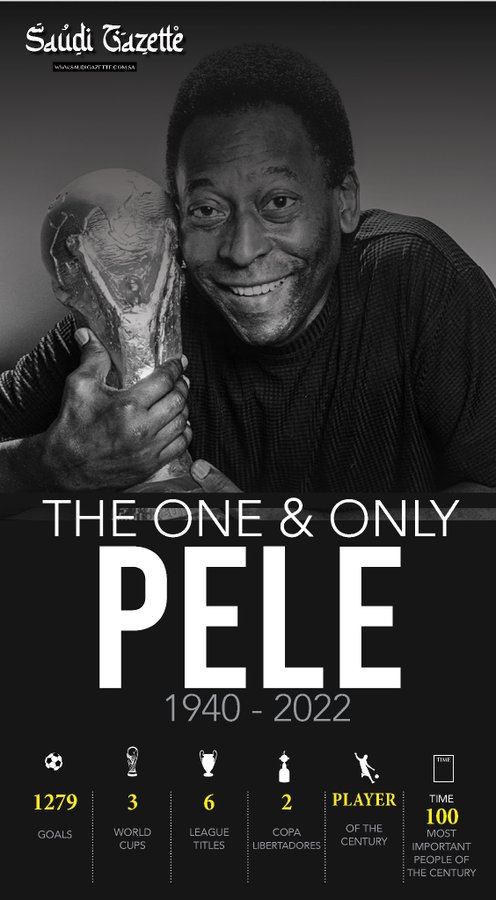 “In the Folha de S.Paulo, journalist Juca Kfouri quoted the late Brazilian poet Carlos Drummond de Andrade, who said: ‘The difficulty, the extraordinary, is not to score 1,000 goals like Pele — it’s to score one goal like Pele.’
“In the Folha de S.Paulo, journalist Juca Kfouri quoted the late Brazilian poet Carlos Drummond de Andrade, who said: ‘The difficulty, the extraordinary, is not to score 1,000 goals like Pele — it’s to score one goal like Pele.’
“Concluding his obituary, Kfouri suggested that while Edson Arantes do Nascimento — Pele’s birth name — may have passed on, ‘it isn’t true that Pele is dead’. . . .”
Some writers addressed the role of race. “If I’d started fighting every time every time they used the n-word in the United States, Latin America and Brazil, I’d still be embroiled in legal cases the world over,” Pelé, sometimes called The Black Pearl, said in a 2015 interview.
In USA Today, sports columnist Mike Freeman wrote, “Pelé’s reach went beyond Brazil. It crossed oceans and mindsets and generations, and if you were Black and played soccer in America, he moved you, in ways few other athletes did. Pelé wasn’t American but for a lot of young Black soccer players it didn’t matter. He was still one of us. He will always be one of us.
“He was Ali, Althea Gibson, Jesse Owens, Bill Russell, Jack Johnson, Serena Williams, Simone Biles and a handful of other Black athletes who reached heights that few people who looked like us ever did.
“He did it with grace, style and class. He stared down racism while growing up Afro-Brazilian, a racial minority. He would address issues of race even if it wasn’t always as much as some people liked.”
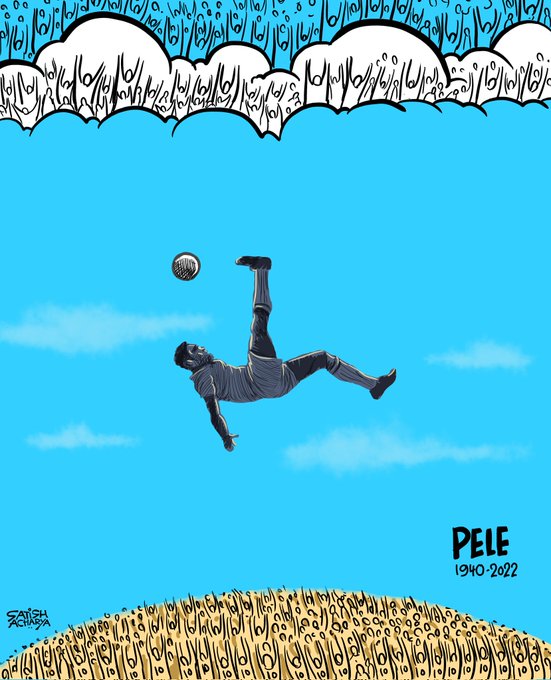 In the New York Times, Tariq Panja, who lived and worked in Brazil from 2013 to 2016, and José Miguel Wisnik, a Brazilian composer and writer who grew up watching Pelé, each addressed the issue. (Cartoon by Satish Agharya, India)
In the New York Times, Tariq Panja, who lived and worked in Brazil from 2013 to 2016, and José Miguel Wisnik, a Brazilian composer and writer who grew up watching Pelé, each addressed the issue. (Cartoon by Satish Agharya, India)
Wisnik wrote, “Behaving in accordance with the dictates of traditional Brazilian cordial sociability, masking insidious structural racism and social inequality, Pelé did not adopt Muhammad Ali’s swaggering rebelliousness, or the passionate, political zigzags of Argentina’s Diego Maradona, nor did he pursue the carnivalesque style and tragic arc of Garrincha, the other great Brazilian star of his generation. Instead he remained a tacit and grandiose witness of Blackness in action.”
Pania wrote, “Brazil, in 1888, was the last Western country to abolish slavery, and Pelé was born just 52 years later, a poor Black child who started out life shining shoes.
“His journey to national hero, after his explosion onto the global consciousness as a teenager, was particularly meaningful for Brazil’s Black population, and for its poor. His popularity also lifted him above the fray of domestic issues, soccer royalty in a nation still finding its way.
“Pelé, sometimes to the frustration of activists, rarely spoke out about racism during his playing career or afterward. He would often repeat the consensus view that Brazil was in fact a ‘racial democracy,’ a position that has been challenged with the growth of the Black consciousness movement. His refusal to take political stands also stood out in a period when Brazil was ruled by a series of dictatorships, during which Brazil’s military sought to take advantage of soccer’s popularity to sustain its hold over the country.
“ ‘I thought his behavior was that of a Black person who only said, “Yes sir,” a Black person who is submissive, accepts everything,’ Paulo Cézar Lima, a former teammate on the Brazilian national team, said in a 2021 Netflix documentary made with Pelé. ‘A single word would have meant so much in Brazil.’
“Yet to some of his other compatriots, Pelé’s very presence as a globally recognized Black Brazilian was enough. Taking on a dictatorship, after all, carried risks. . . .”
- Agence France-Presse: Marriages, music, endorsements: Pele’s life away from the field
- allafrica.com: Africa Mourns Pele, ‘King of Football’
- Andrew Downie, Reuters: ‘The summit of world football’: what Pele did for Brazil
- Deron Snyder, The Grio: How Pelé kicked off a soccer revolution in America

Buffalo Columnist Says Blizzard Surfaced Racists
“Four Buffalo residents have been charged in connection with looting stores during the blizzard that pummeled Western New York over the Christmas weekend, according to the Erie County District Attorney’s Office,” Natalie Brophy wrote Wednesday in the Buffalo News. “Meanwhile, Buffalo Police announced on Twitter Wednesday night that a 10th person has been arrested by the Anti-Looting Detail.”
The blizzard, which dumped four feet of snow, packed winds as high as 70 miles per hour and left at least 40 people dead, was an occasion for racism to rear its head, according to Buffalo News columnist Rod Watson (pictured, below).
“The emails were as predictable as the blizzard itself,” Watson wrote Tuesday.
“ ‘I suppose you would like to again, somehow blame the despicable act of looting in Buffalo on “poor education and upbringing” … Lets stop wondering why the east side of Buffalo has such a hard time attracting businesses. We all know why,’ wrote one apostrophe-challenged reader.
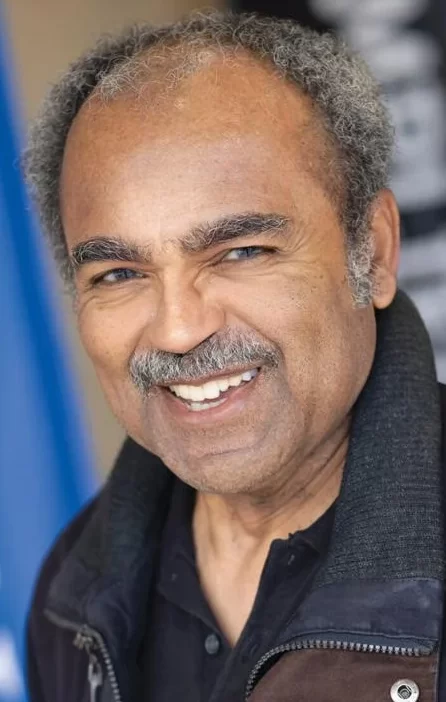 “ ‘What a shock. When times are tough, the blacks never disappoint. Did you loot anything? Amazing how there aren’t videos of Asians, Whites, Arabs or Latinos looting Buffalo. Just the usual suspects … It’s never going to change,’ wrote another.
“ ‘What a shock. When times are tough, the blacks never disappoint. Did you loot anything? Amazing how there aren’t videos of Asians, Whites, Arabs or Latinos looting Buffalo. Just the usual suspects … It’s never going to change,’ wrote another.
“At least he’s right about the last part: Attitudes like his probably are never going to change.
“As to his other point, I have no idea if there was looting in other neighborhoods. That’s not where cameras and journalists typically look for it, and suburban officials don’t generally broadcast their community’s shortcomings. . . .”
Brophy wrote, “Prosecutors say Felix Ramos, 46, on Monday morning burglarized the Family Dollar store in the 400 block of William Street in Buffalo. . . . Luiman E. Velez, 55, is facing charges of third-degree burglary and attempted petit larceny. . . . Prosecutors accuse Shaniece A. Jones, 34, of “knowingly entering and remaining unlawfully inside” the Family Dollar store. . . . Aaron Peterson, 57, is accused of pointing an illegal gun at a victim Sunday afternoon near a Family Dollar. . . .
“Buffalo police put together an anti-looting task force to investigate additional looting incidents. At least nine people have been arrested in connection with the looting incidents, Buffalo Police Department Commissioner Joseph Gramaglia said during a news conference Wednesday morning. . . .”

Small Paper’s Alarm on Santos Was Ignored
“Months before the New York Times published a December article suggesting Rep.-elect George Santos (R-N.Y.) had fabricated much of his résumé and biography, a tiny publication on Long Island was ringing alarm bells about its local candidate,” Sarah Ellison wrote Thursday for the Washington Post.
“The North Shore Leader wrote in September, when few others were covering Santos, about his ‘inexplicable rise’ in reported net worth — from essentially nothing in 2020 to as much as $11 million two years later.
“The story noted other oddities about the self-described gay Trump supporter with Jewish heritage, who would go on to flip New York’s 3rd Congressional District from blue to red, and is now under investigation by authorities for misrepresenting his background to voters.
“ ‘Interestingly, Santos shows no U.S. real property in his financial disclosure, although he has repeatedly claimed to own “a mansion in Oyster Bay Cove” on Tiffany Road; and “a mansion in the Hamptons” on Dune Road,’ managing editor Maureen Daly wrote in the Leader. ‘For a man of such alleged wealth, campaign records show that Santos and his husband live in a rented apartment, in an attached rowhouse in Queens.’ ”
Ellison also wrote, “It was the stuff national headlines are supposed to be built on: A hyperlocal outlet like the Leader does the leg work, regional papers verify and amplify the story, and before long an emerging political scandal is being broadcast coast-to-coast.
“But that system, which has atrophied for decades amid the destruction of news economies, appears to have failed completely this time. Despite a well-heeled and well-connected readership — the Leader’s publisher says it counts among its subscribers Fox News hosts Sean Hannity and Jesse Watters and several senior people at Newsday, a once-mighty Long Island-based tabloid that has won 19 Pulitzers — no one followed its story before Election Day. . . .”
“Kim Como, a spokeswoman for Newsday, did not answer specific questions about the paper’s coverage of Santos but said in a statement: ‘We are continuing to cover the Santos story every day. . . .’ ”
-
Niall Fitzgerald, North Shore Leader: The Leader Told You So: US Rep-Elect George Santos is a Fraud – and Wanted Criminal
- Renée Graham, Boston Globe: George Santos — the lying-est Republican who ever lied (since Trump)
- Kipp Jones, Mediaite: “Jason Whitlock Blames George Santos’ Lies on America Abandoning God: ‘Power by Any Means Necessary – On Both Sides’
- NBC News: These Latino firsts made history in the 2022 midterm elections (Nov. 9)
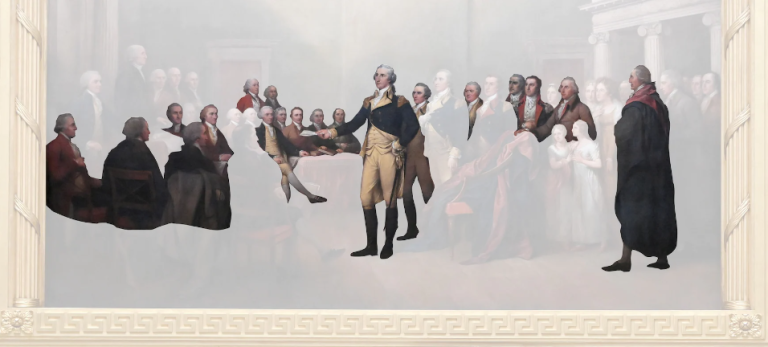
U.S. Capitol Features Tributes to 140 Enslavers
“When the 118th Congress is sworn in on Jan. 3, its members will walk the halls of a building whose paintings and statues pay homage to 140 enslavers,” Gillian Brockell reported Tuesday for The Washington Post.
“As part of a yearlong investigation into Congress’s relationship with slavery, The Washington Post analyzed more than 400 artworks in the U.S. Capitol building, from the Crypt to the ceiling of the Capitol Rotunda, and found that one-third honor enslavers or Confederates. Another six honor possible enslavers — people whose slaveholding status is in dispute. . . .”
Brockell also wrote, “Some of the artworks reflect the reality that most of the nation’s prominent founders were also enslavers; there are 17 depictions of George Washington, nine of Thomas Jefferson and five of James Madison. But there are also 15 depictions of Christopher Columbus, who never set foot in North America and enslaved Indigenous people in the Caribbean. The majority of the artworks honor lesser-known figures who were deeply involved in the African slave trade, the enslavement of Indigenous people, forced plantation labor and the war fought to preserve slavery. Two statues portray physicians who experimented on enslaved people.
“None of the works are accompanied by any acknowledgement that their subjects enslaved people. . . .”
- H.R. Harris, Afro: Mary McCleod Bethune Statue Unveiled in U.S. Capitol – First Black Statue in Statuary Hall (July 15)
- Benedict Moran and Anne Azzi Davenport, “PBS NewsHour”: Activists fight to memorialize site of largest slave auction in American history [in Savannah, Ga.]
- Patrick Young, esq., “The Reconstruction Era” blog: A Third of the People Depicted in Art at the National Capitol in Washington are Enslavers
- Saraya Wintersmith, WGBH News, Boston: Boston City Council unanimously approves reparations study task force (Dec. 14)

Reporter Finds Russian ‘Vassal State’ in Africa
“With his invasion of Ukraine, President Vladimir V. Putin of Russia unleashed a new disorder on the world,” Roger Cohen (pictured, below) reported Dec. 24, updated Tuesday, in a front-page story in The New York Times Sunday print edition.
 “Ukraine has portrayed its fight against becoming another Russian vassal as one for universal freedom, and the cause has resonated in the United States and Europe. But in the Central African Republic, Russia already has its way, with scant Western reaction, and in the flyblown mayhem of its capital, Bangui, a different kind of Russian victory is already on display.
“Ukraine has portrayed its fight against becoming another Russian vassal as one for universal freedom, and the cause has resonated in the United States and Europe. But in the Central African Republic, Russia already has its way, with scant Western reaction, and in the flyblown mayhem of its capital, Bangui, a different kind of Russian victory is already on display.
“Russian mercenaries with the same shadowy Wagner Group now fighting in Ukraine bestride the Central African Republic, a country rich in gold and diamonds. Their impunity appears total as they move in unmarked vehicles, balaclavas covering half their faces and openly carrying automatic rifles. The large mining and timber interests that Wagner now controls are reason enough to explain why Russia wants no threat to a compliant government.
“From Bangui itself, where Wagner forces steal and threaten, to Bria in the center of the country, to Mbaiki in the south, I saw Moscow’s mercenaries everywhere during a two-and-a-half-week stay, despite pressure on them to rotate to fight in Ukraine.
“They threaten stability, they undermine good governance, they rob countries of mineral wealth, they violate human rights,” Secretary of State Antony J. Blinken said of Wagner operatives last week during a U.S.-Africa Leaders Summit in Washington. . . .”
Cohen also wrote, “Tired of Western hypocrisy and empty promises, stung by the shrug that war in Africa elicits in Western capitals as compared with war in Ukraine, many people I met were inclined to support Mr. Putin over their former colonizers in Paris. If Russian brutality in Bucha or Mariupol appalls the West, Russian brutality in the Central African Republic is widely perceived to have helped quiet a decade-old conflict. . . .”
- Joseph Siegle, Italian Institute for International Political Studies, Milan: Russia and the Future International Order in Africa

Uganda Paper Exposes Saudis’ Human Trafficking
“She will work day and night and does not need rest, boasts Noura, a housewife in Riyadh,” the Nation group of newspapers reported from Uganda reported Friday. “Gesturing to the cowering Ugandan maid next to her, who is 23 according to Noura, she adds: ‘If she does something wrong, you just send her to her room and do not let her out.’ ”
“Noura, who clutches gold Gucci sunglasses as she bargains for a price of £3,500 (about Shs15.6m) for the maid, is eager for a quick deal when she talks to an undercover Times reporter. ‘I can take her to your home tonight,’ she says. ‘If you are still unsure, no problem, you can rent her instead . . . But tell me now, because by tomorrow someone else will buy her.’
“Noura advertised the domestic worker on Haraj.sa, Saudi Arabia’s largest online marketplace, through which a Times investigation shows that hundreds of domestic workers are being illegally trafficked and sold to the highest bidders.
“In a thinly disguised black market, dozens of listings are posted each day by Saudi citizens advertising migrant workers as available to buy or rent as maids, cleaners, nannies and drivers. Two hundred such listings have been seen by The Times.
“The app, which had 2.5 million visits last year — more than Amazon or AliExpress within the kingdom — is still available on the Apple and Google Play stores despite being criticised by the UN’s Special Rapporteurs in 2020 for facilitating modern slavery. . . .”

Watch, Listen to the Top African Songs of 2022
“Towards the end of every year, Music In Africa’s editorial team – comprising editors and contributors from across the continent – compiles a playlist with a selection of some of the biggest tracks of the past 12 months,” the Johannesburg-based Music in Africa wrote Tuesday. “The below playlist is divided into six regions [of Africa], with each region bearing five tracks that made an impression on the local music scene and the journalists who selected them. . . . “
YouTube videos of the songs are included.
- Sean Barlow: afropop.org: Creative Industries Flourish at U.S. Africa Leaders Summit (Dec. 20)
- Molly Callahan, Boston University: Unearthing a Long Ignored African Writing System, One Researcher Finds African History, by Africans (Dec. 21)
Short Takes
- “ ‘GMA3’ host T.J. Holmes filed for divorce from his estranged wife Marilee Fiebig on Wednesday, after news broke of his relationship with co-host Amy Robach,” Ben Blanchet reported Thursday for HuffPost. “The anchor’s divorce filing from his wife of over 12 years comes nearly a month after photographs published in the Daily Mail revealed he and Robach were spending time together, including at an alleged stay at a “secluded cottage in Upstate New York” in November, according to TMZ. . . .”
 “Long-time Philadelphia journalist Donald Hunt (pictured) has been named the recipient of the 2022 Football Writers Association of America’s Lifetime Achievement Award,” the association announced on Thursday. “Hunt retired in December 2021 after a 43-year career, mainly at the Philadelphia Tribune, the oldest continuously published African American newspaper in the country. He has been a member of the FWAA for nearly 35 years. And he has a long list of previous honors that include membership in the Philadelphia Sports Hall of Fame and Philadelphia Black Basketball Hall of Fame and NABJ [Sports Task Force] Journalist of the Year in 2011 by the National Association of Black Journalists. He is the first African American sportswriter to go into the Philadelphia Sports Hall of Fame. . . .”
“Long-time Philadelphia journalist Donald Hunt (pictured) has been named the recipient of the 2022 Football Writers Association of America’s Lifetime Achievement Award,” the association announced on Thursday. “Hunt retired in December 2021 after a 43-year career, mainly at the Philadelphia Tribune, the oldest continuously published African American newspaper in the country. He has been a member of the FWAA for nearly 35 years. And he has a long list of previous honors that include membership in the Philadelphia Sports Hall of Fame and Philadelphia Black Basketball Hall of Fame and NABJ [Sports Task Force] Journalist of the Year in 2011 by the National Association of Black Journalists. He is the first African American sportswriter to go into the Philadelphia Sports Hall of Fame. . . .”
- Street Sense Media, a nonprofit newsroom based in Washington, has produced “A journalist’s guide to reporting on homelessness.” “In summer 2022, our team conducted around 30 interviews with journalists, homeless rights advocates, government officials and homeless people from across the country. We also conducted a survey to gather input from the broader public about how they feel homelessness is covered in the media and what journalists can do better,” the group says.
- “Spelman College announced a $1 million gift from the Jonathan Logan Family Foundation to establish the Jonathan Logan Family Foundation Center for Documentary Media Studies in the new Mary Schmidt Campbell, Ph.D., Center for Innovation & the Arts.,” the college announced Dec. 16. “Spelman College is the first Historically Black College & University (HBCU) to offer a bachelor’s degree in documentary filmmaking. . . .”
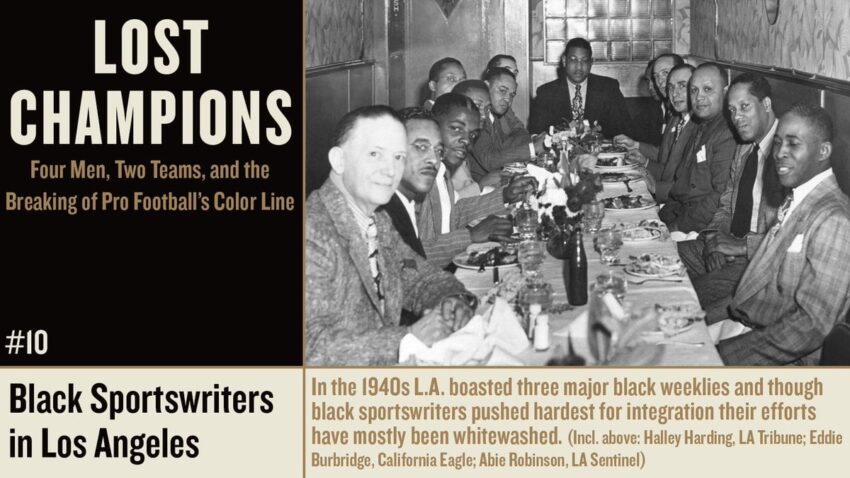
- Writing for the Denver Broncos, Jim Saccomano describes the role of Black journalists in integrating the team: ” ‘There were several African-American newspapers (the Sentinel, the California Eagle, and the Tribune) in Los Angeles at the time and the sports editors of those publications got together and appointed Los Angeles Tribune sports editor Halley Harding to ask at the meeting of the Coliseum Commission for the Rams to sign an African-American player,’ Bob Timmermann, a senior librarian for the Los Angeles Public Library wrote in 2017. ‘If the team did not acquiesce to that request, Harding would inform the team that it would face legal action because, since the Coliseum was taxpayer-supported, it could not host a segregated for profit sports team. ‘ As a result, on March 21, [Rams owner Dan] Reeves and the Rams signed halfback Kenny Washington, and they followed that up with the signing of end Woody Strode not long afterward. Washington and Strode became the first Black men to play in the NFL in the post-war era.”
- “The Academy of Motion Picture Arts and Sciences announced shortlists in 10 awards categories for the 95th Academy Awards, recognizing ‘Happiness Is £4 Million,’ an Op-Doc from New York Times Opinion video for consideration in the documentary short film category,” the Times announced Dec. 22. “The film, released in Nov. 2022 by Times Opinion, is a textured portrait of a Chinese real estate speculator and the young journalist [Cici Fenfeng Wu] assigned to profile him. The study of wealth accumulation, ambition and the force of personality is a vivid window into China’s society. . . .”
- “The editor of one of Algeria’s last remaining independent media outlets was charged on Thursday with publishing articles that threaten national security and receiving suspicious funding from foreign sources, days after security officials shut down his internet radio station in an escalation of the North African country’s crackdown on dissent and free press,” Vivian Yee reported Thursday for The New York Times. “The editor, Ihsane El-Kadi, is a prominent journalist who heads Radio M and its sister news site. He has been in detention since plainclothes security agents arrested him early on Saturday at his home east of Algiers, the capital, said his daughter, Tin Hinane El-Kadi. . . .”
To subscribe at no cost, please send an email to journal-isms+subscribe@groups.io and say who you are.
Facebook users: “Like” “Richard Prince’s Journal-isms” on Facebook.
Follow Richard Prince on Twitter @princeeditor
Richard Prince’s Journal-isms originates from Washington. It began in print before most of us knew what the internet was, and it would like to be referred to as a “column.” Any views expressed in the column are those of the person or organization quoted and not those of any other entity. Send tips, comments and concerns to Richard Prince at journal-isms+owner@
View previous columns (after Feb. 13, 2016).
View previous columns (before Feb. 13, 2016)
- Diversity’s Greatest Hits, 2018 (Jan. 4, 2019)
- Book Notes: Is Taking a Knee Really All That? (Dec. 20, 2018)
- Book Notes: Challenging ’45’ and Proudly Telling the Story (Dec. 18, 2018)
- Book Notes: Get Down With the Legends! (Dec. 11, 2018)
- Journalist Richard Prince w/Joe Madison (Sirius XM, April 18, 2018) (podcast)
- Richard Prince (journalist) (Wikipedia entry)
- February 2018 Podcast: Richard “Dick” Prince on the need for newsroom diversity (Gabriel Greschler, Student Press Law Center, Feb. 26, 2018)
- Diversity’s Greatest Hits, 2017 — Where Will They Take Us in the Year Ahead?
- Book Notes: Best Sellers, Uncovered Treasures, Overlooked History (Dec. 19, 2017)
- An advocate for diversity in the media is still pressing for representation, (Courtland Milloy, Washington Post, Nov. 28, 2017)
- Morgan Global Journalism Review: Journal-isms Journeys On (Aug. 31, 2017)
- Diversity’s Greatest Hits, 2016
- Book Notes: 16 Writers Dish About ‘Chelle,’ the First Lady
- Book Notes: From Coretta to Barack, and in Search of the Godfather
- Journal-isms’ Richard Prince Wants Your Ideas (FishbowlDC, Feb. 26, 2016)
- “JOURNAL-ISMS” IS LATEST TO BEAR BRUNT OF INDUSTRY’S ECONOMIC WOES (Feb. 19, 2016)
- Richard Prince with Charlayne Hunter-Gault, “PBS NewsHour,” “What stagnant diversity means for America’s newsrooms” (Dec. 15, 2015)
- Book Notes: Journalists Follow Their Passions
- Book Notes: Journalists Who Rocked Their World
- Book Notes: Hands Up! Read This!
- Book Notes: New Cosby Bio Looks Like a Best-Seller
- Journo-diversity advocate turns attention to Ezra Klein project (Erik Wemple, Washington Post, March 5, 2014)
When you shop @AmazonSmile, Amazon will make a donation to Journal-Isms Inc. https://t.co/OFkE3Gu0eK
— Richard Prince (@princeeditor) March 16, 2018

